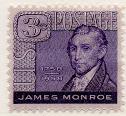by Marsha Brandsdorfer
The White House is celebrated in stamps. Its history is long and colorful. But on August 25, 1814, the White House was destroyed, looted and burnt, along with many other government buildings during the British invasion of The War of 1812.
 Prior to this attack of Washington, D.C., President James Madison, who anticipated such an occurrence when British troops were stationed at the port of Benedict, Maryland, ordered that records be removed from the Department of State. The staff tried to save as many federal records and valuable archives as possible, including the Declaration of Independence, and the Bill of Rights. The documents were moved to Leesburg, Virginia, which was about thirty-five miles outside of the city, where they were locked in a cellar vault of an abandoned house.
Prior to this attack of Washington, D.C., President James Madison, who anticipated such an occurrence when British troops were stationed at the port of Benedict, Maryland, ordered that records be removed from the Department of State. The staff tried to save as many federal records and valuable archives as possible, including the Declaration of Independence, and the Bill of Rights. The documents were moved to Leesburg, Virginia, which was about thirty-five miles outside of the city, where they were locked in a cellar vault of an abandoned house.
 At the White House, first lady Dolley Madison helped to save the Gilbert Stuart 1797 life-size painting of former President George Washington, and cabinet papers. Their items ended up at the Bank of Maryland in Baltimore for safe keeping. The documents that were saved continued to remain in various stages of storage until they could be transferred to the National Archives which was built in 1935. Many documents and valuables, however, were left behind in the haste to get out of Washington, D. C.
At the White House, first lady Dolley Madison helped to save the Gilbert Stuart 1797 life-size painting of former President George Washington, and cabinet papers. Their items ended up at the Bank of Maryland in Baltimore for safe keeping. The documents that were saved continued to remain in various stages of storage until they could be transferred to the National Archives which was built in 1935. Many documents and valuables, however, were left behind in the haste to get out of Washington, D. C.
As predicted, the British invaded Washington, D, C, and they destroyed as many public buildings as possible, including burning the White House. They also destroyed most of the rest of the records left in the city.
Initially, after the invasion, there was a question as to whether Washington, D.C. should remain the capital or if it should be abandoned and moved elsewhere. However, Congress decided to keep the capital where it was, and to concentrate on rebuilding the city. As the damage was extensive, it took years for the White House to be cleaned up from the debris from the fire, and it was reconstructed by its original architect, James Hoban.
to whether Washington, D.C. should remain the capital or if it should be abandoned and moved elsewhere. However, Congress decided to keep the capital where it was, and to concentrate on rebuilding the city. As the damage was extensive, it took years for the White House to be cleaned up from the debris from the fire, and it was reconstructed by its original architect, James Hoban.
When James Monroe became the fifth President of the United States in 1817, he would become involved in acquiring interior furnishings. He wanted to obtain “articles of the best kind.” Monroe offered furniture from his Paris home to decorate the White House. Other furniture was bought in Washington, D.C. and Philadelphia. Through the passage of time, some of the original items remained, some were lost or damaged, and many of the original pieces can now be viewed at the James Monroe Museum and Memorial Library located in Fredericksburg, Virginia. All succeeding Presidents continued the tradition of trying to seek out “articles of the best kind” to decorate the White House.
 My research came from the White House History, Journal No. 35, entitled “After the Fire,” published by the White House Historical Association.
My research came from the White House History, Journal No. 35, entitled “After the Fire,” published by the White House Historical Association.

